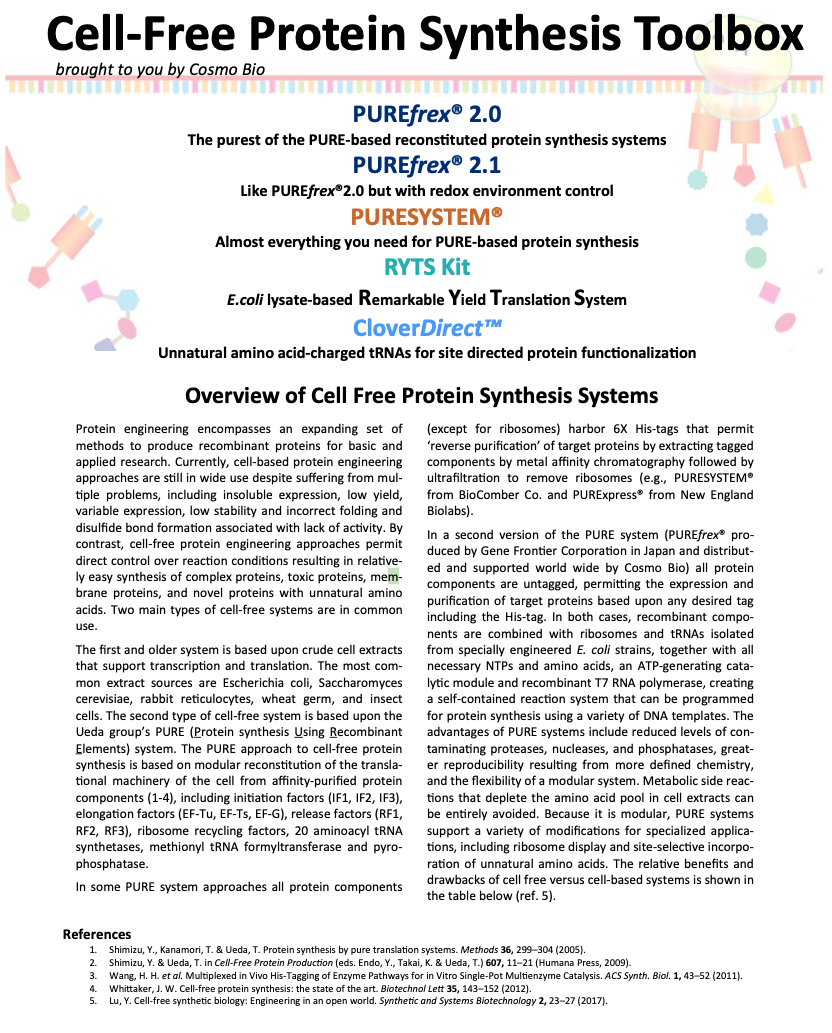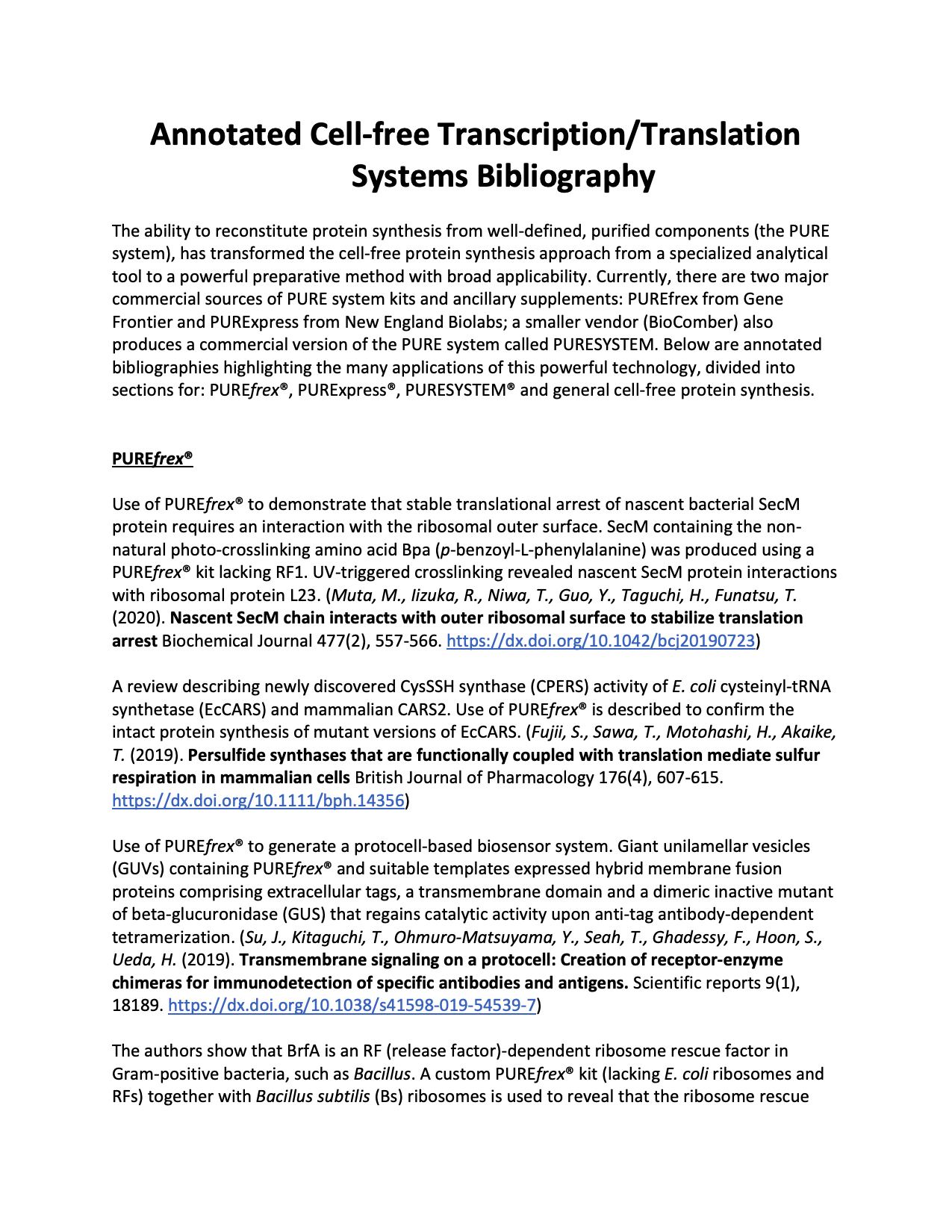Cell-Free Protein Synthesis Toolbox
PUREfrex® 2.0 The purest of the PURE-based reconstituted protein synthesis system kits
PUREfrex® 2.1 Like 2.0 but with redox environment control
CloverDirect™ Non-natural amino acid-charged tRNAs for site directed protein functionalization
PURESYSTEM® Almost everything you need for PURE-based protein synthesis
RYTS Kit E. coli lysate-based Remarkable Yield Translation System
 |
 |
| Download Cell-Free Protein Synthesis Flyer |
Download Annotated Cell-Free Protein Synthesis Bibliography |
CLICK TO VIEW COMPREHENSIVE ANNOTATED BIBLIOGRAPHY
Overview of Cell Free Protein Synthesis Systems
Protein engineering encompasses an expanding set of methods to produce recombinant proteins for basic and applied research. Currently, cell-based protein engineering approaches are still in wide use despite suffering from multiple problems, including insolubility, low yield, variable expression, low stability, incorrect folding and incorrect disulfide bond formation associated with lack of activity. By contrast, cell-free protein engineering approaches permit direct control over reaction conditions resulting in relatively easy and rapid synthesis of complex proteins, toxic proteins, membrane proteins, and novel proteins with non-natural amino acids.
Two main types of cell-free systems are in common use. The first and older system is based upon crude cell extracts that support transcription and translation. The most common extract sources are Escherichia coli, Saccharomyces cerevisiae, rabbit reticulocytes, wheat germ, and insect cells. The second type of cell-free system is based upon the Ueda group’s PURE (Protein synthesis Using Recombinant Elements) system. The PURE approach to cell-free protein synthesis is based on modular reconstitution of the translational machinery of the cell from affinity-purified protein components (1-4), including initiation factors (IF1, IF2, IF3), elongation factors (EF-Tu, EF-Ts, EF-G), release factors (RF1, RF2, RF3), ribosome recycling factors, 20 aminoacyl tRNA synthetases, methionyl tRNA formyltransferase and pyrophosphatase.
In some PURE system approaches all protein components (except for ribosomes) harbor 6X His-tags that permit ‘reverse purification’ of target proteins by extracting tagged components by metal affinity chromatography followed by ultrafiltration to remove ribosomes (e.g., PURESYSTEM® from BioComber Co. and PURExpress® from New England Biolabs).
In a second version of the PURE system (PUREfrex® produced by Gene Frontier Corporation in Japan and distributed and supported world wide by Cosmo Bio) all protein components are untagged, permitting the expression and purification of target proteins based upon any desired tag including the His-tag. In both cases, recombinant components are combined with ribosomes and tRNAs isolated from specially engineered E. coli strains, together with all necessary NTPs and amino acids, an ATP-generating catalytic module and recombinant T7 RNA polymerase, creating a self-contained reaction system that can be programmed for protein synthesis using a variety of DNA templates. The advantages of PURE systems include reduced levels of contaminating proteases, nucleases, and phosphatases, greater reproducibility resulting from more defined chemistry, and the flexibility of a modular system. Metabolic side reactions that deplete the amino acid pool in cell extracts can be entirely avoided. Because they are modular, PURE systems support a variety of modifications for specialized applications, including ribosome display and site-selective incorporation of non-natural amino acids. The relative benefits and drawbacks of cell free versus cell-based systems is shown in the table below (ref. 5).
References
1. Shimizu, Y., Kanamori, T. & Ueda, T. Protein synthesis by pure translation systems. Methods 36, 299–304 (2005).
2. Shimizu, Y. & Ueda, T. in Cell-Free Protein Production (eds. Endo, Y., Takai, K. & Ueda, T.) 607, 11–21 (Humana Press, 2009).
3. Wang, H. H. et al. Multiplexed in Vivo His-Tagging of Enzyme Pathways for in Vitro Single-Pot Multienzyme Catalysis. ACS Synth. Biol. 1, 43–52 (2011).
4. Whittaker, J. W. Cell-free protein synthesis: the state of the art. Biotechnol Lett 35, 143–152 (2012).
5. Lu, Y. Cell-free synthetic biology: Engineering in an open world. Synthetic and Systems Biotechnology 2, 23–27 (2017).


